As an Amazon Associate I earn from qualifying purchases.
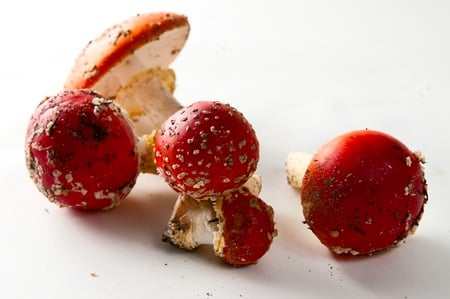
Editor’s Note: I have said this a lot in the comments before, in person and in the body of this post. Let me say it one more time, right up here in the beginning: Unless you are an expert mushroom hunter and you can 100 percent identify this mushroom, DON’T EAT IT. I wrote this post for other experts, not for just anyone to think they’ve found A. muscaria. This is serious stuff, folks. Mistake this mushroom for another amanita and you can die. Seriously. ~Hank
No mushroom presents more of an enigma than the fly agaric, Amanita muscaria. It is the most recognizable mushroom on the planet, and is widely known as the hallucinatory ‘shroom responsible for Alice’s trip into Wonderland and quite possibly our beloved images of a red-suited Santa Claus and his flying reindeer.
I am not into hallucinations. Or stomach cramping, for that matter. So for years I let this beautiful mushroom pass on my mushroom hunts. Until last weekend. We were ostensibly hunting for porcini, Boletus edulis, but as any king bolete hunter knows, the fly agaric is literally a red flag indicating that a porcino might be nestled nearby: They flush around the same time, in around the same place. And where we were on California’s Central Coast there were thousands of muscaria, a red tide in the woods.

As we walked, picking porcini and other wonderful boletes, I began having a nagging conversation with myself: You know you can eat those amanitas, right? Yes, but don’t they need all sorts of crazy processing first? Probably. But you will never get a better chance to experiment than with this flush right here, right now. OK, OK. I grabbed a separate bag and began picking.
I filled a grocery bag in no time. In fact, I could have filled the back of my pickup with muscaria. But I also had a huge haul of porcini, the prize of the day. So I dealt with them first. My dehydrator ran morning and night for days. I made porcini powder, dried quarts of porcini, made porcini risotto, and even gave some fresh ones as Christmas presents. All the while my sack of amanitas lay neglected in the garage.
I came up for air a few days ago and decided to do some research. I have a lot of mushroom books. Most say that Amanita muscaria is toxic and hallucinatory. A few call it deadly poisonous, which seems to be a stretch considering there are fewer than a handful of confirmed deaths by this mushroom and all have extenuating circumstances. (A side note: fly agaric appears to be attractive to dogs and cats and can kill them if they eat it, so keep it away from your pets!)
There is also, apparently, an entire modern subculture dedicated to tripping on this mushroom, and its use in visions dates back thousands of years — especially among those who live in the boreal forests of the north.
This is where Santa comes in. My colleague Greg Marley, whose excellent book Chanterelle Dreams, Amanita Nightmares: The Love, Lore, and Mystique of Mushrooms goes into this at length, says that fly agaric has been a symbol of yuletide happiness in Central Europe, Russia and Scandinavia for centuries, calling it “a red light shining bright in the winter darkness.” And the people of the North, as any mushroom hunter knows, are mad about mushrooms.
There is a common exchange between us Anglo ‘shroomers when we see various, “lesser” species of ‘shroom: Is it edible? Well, the Russians eat it… Amanita muscaria falls into this category.
Historically, the Siberians boiled fly agaric and then drank the pot liquor to get roaring drunk. They then preserved the mushrooms for eating later. As it happens, the Siberians’ livestock also loves this ‘shroom. And I’m not talking about cattle, I’m talking about reindeer.
Yep. Caribou will seek out Amanita muscaria just for the high — or at least it looks that way to us humans. So it’s not too far a stretch to conjure up an image of a jolly, roaringly drunk, fat, bearded dude all dressed up for the North Pole — in a red suit with white trim — chillin’ with flying reindeer.
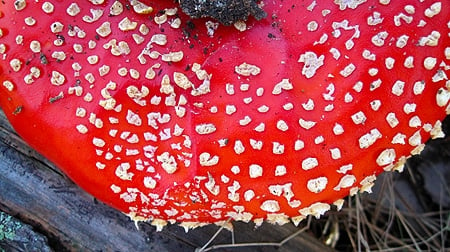
But like I said, I am not into that sort of thing. So I looked deeper. It seems that the primary toxins, er, “active ingredients,” in Amanita muscaria are ibotenic acid and muscimol. Unlike the amatoxins in the deadly amanitas — the death cap and the destroying angel — ibotenic acid and muscimol are water soluble.
More research turned up William Rubel, who knows his stuff when it comes to mushrooms. Rubel wrote an article about how to detoxify fly agaric that proved enlightening.
What’s more, he and David Arora, who is even more reknowned in the mycological world, teamed up on a longer piece (which is linked to at the bottom of Rubel’s article) about cultural attitudes toward Amanita muscaria that provides all the detail you could need on why this mushroom has such a varied place in our minds: Food. Poison. Hallucinogen.
As food, fly agaric does need special handling. Apparently most people eat only the caps or the very young buttons. They must be boiled in a large volume of water for a period of time, and then you need to toss out that water. After that, most cultures will either fry them like normal mushrooms, or pickle them, or preserve them in oil; I happen to know that a certain set of Italians do this. The Japanese around Nagano eat Amanita muscaria as pickles, as do the Lithuanians, Finns and Russians.
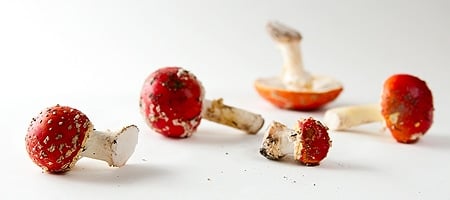
My friend Langdon Cook wrote about eating fly agaric with none other than David Arora, and he pronounced them delicious. Lang also pointed me to a cautionary article written by two mycologists who, apparently, failed to detoxify their muscaria enough. The moral of that article is to use lots of water and boil the hell out of the shrooms.
Back to my grocery bag. By the time I’d screwed up enough courage to mess around with these things, about half had gone by. Bummer. But I still had about 10 good caps to experiment with. What follows is what I did to detoxify the mushrooms. If you choose to play around with Amanita muscaria, do so at your own risk.
- I first removed all the caps and cleaned them with a brush and the side of a knife. Then I cut the caps into 1/4 inch slices.
- I filled my 12-quart stockpot up to the top, leaving about 3 inches of room to spare. I added enough salt to make the water taste salty and 1 cup of cider vinegar. Several sources say that adding salt and vinegar helps extract the toxins.
- I brought this to a boil and added the mushroom caps, then let it roll for 15 minutes.
- I then drained the mushrooms and filled the stockpot half full with fresh water and brought that to a boil. In went the mushrooms for another 5 minutes. Why? If they had gotten too vinegary or salty, this would help. Also, better safe than sorry.
The key to boiling seems to be time and water volume. You need enough water to leach out all the toxins of the mushroom, so it follows that the more muscaria you boil, the more water you’ll need. As for time, it seems 15 minutes is a pretty good interval, according to my sources.
When the slices were done with this treatment, almost all the color was gone from the previously pretty red caps. Oh well. They were still a vague ivory-yellow, but the mushrooms themselves were pale and slippery. Not appetizing. Lang and Arora ate them fried in butter, so I did the same.
I experimented with about 1 cap’s worth of slices. It is always wise to start small with any new mushroom, and especially one that has potentially toxic effects. I put the slices into a non-stick pan and let them dry saute for a few minutes. They did not exude too much water, oddly, so I added some butter and a little salt. I was happy to see the slices fry up crispy. Now we’re talking!
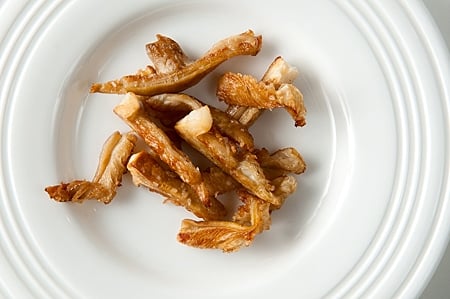
I put them on a little plate, and tentatively took a bite. I’d be lying if I told you I was not at least a little nervous. I tasted butter and salt at first, always nice, but then I got a little crisp, then the squinchy crunchiness of the mushroom, then that nutty flavor everyone who’s eaten muscaria talks about. Reflexively, I reached for another slice, then another and another.
I had to force myself to stop at 1 cap’s worth. They were that good. Now it was time to wait.
The mycologists who’d boiled their muscaria in too little water for too short a time started tripping at 20 minutes. So I sat down to watch Boise State beat the crap out of Arizona State and waited. I was wondering if Boise’s crazy blue uniforms would spark some weird hallucination. But no. I looked at my watch: 45 minutes and nothing. The game got boring. Holly and I then watched a show about a bunch of Vikings getting beheaded in England 1000 years ago, which, in retrospect, was probably not ideal if I were about to go on a mushroom trip. But no. I looked at my watch again: Two hours had passed and nothing.
If a trip were coming, it would have hit by then. What’s more, I had neither stomach cramps nor any other ill effects whatsoever. Success!
Now you may be asking yourself why I would bother messing around with Amanita muscaria when I had just hauled in pounds of boletes? First off, fly agaric is one of the easiest mushrooms in the world to identify. Even though it has some color variation, like the yellow-orange one below, if you stick to the red and orange color phases Amanita muscaria is unmistakable.
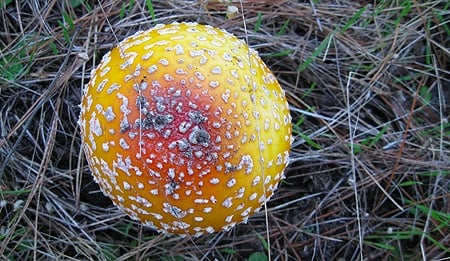
Now white and light-yellow phase muscaria do exist, but I do not recommend messing with those. White amanitas are almost always deadly — the destroying angel chief among them — and mistaking a destroying angel for a white muscaria will be the last mistake you ever make.
And with the yellow ones, you can mistake muscaria for the more-toxic Panther Amanita, Amanita pantherina, which does not have a history of culinary use.
A second reason to consider eating fly agaric is because it is a large mushroom that, as I saw on the Central Coast, can flush in huge numbers. I could easily have collected four grocery bags of them on my last trip, which would have made for lots of good eating down the line.
And good eating is the real reason I will choose to eat Amanita muscaria once or twice a season. It was a delicious mushroom fried in butter, and I suspect it will make an even better preserved mushroom, if the Italians or Russians’ experience is any indication. At the very least, it will be a conversation starter, eh?

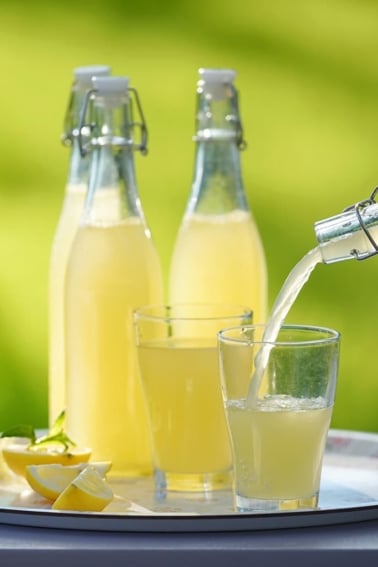
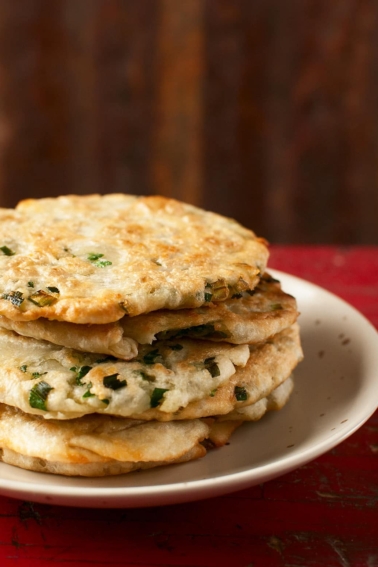


Hank. Great article! I am wondering, however, what your references might be to A. muscaria being used a pickle in Lithuania and Russia. I have spent time in Lithuania. Nobody I met ate A. muscaria. Thanks.
Just a quick correction: Finns definitely don’t eat Amanita muscaria as pickles. We do eat well boiled Gyromitra esculenta.
Lots of them in wilderness lost creek park county colorado behind our house. Walk every night all kinds of mushrooms wet year no doubt we know these things as we are in the woods alot. Dont know the mushrooms as which are edible, which are.trips or which are posionous so we just admire all of them..we look for mushroom lines sometimes they grow in patterns. Quite entertaining and coolio..
I ate a dried one I purchased on line. I didn’t know any preparation was necessary. It was an intensely long strange trip. No noticeable side effects like stomach ache. But I prefer LSD and wish it were legal.
The muscomol and ibonic acid are water soluble that’s why you boil them, to remove the muscomol and ibonic acid. That’s why you didn’t trip. You’re supposed to drink the water. I believes it is highly soluble in water, and and mostly concentrated on the surface of the cap. So soak them in ice water stirring occasionally for a few hours and it should remove the “toxins” which is the muscomol and ibonic acid. So you essentially threw out the active ingredient, and if you use ice water, they won’t get soft and gelatinous, easier frying. I just pick them wiped them off and eat them right there.
Thank you for sharing and spreading awareness! Mushrooms are really indeed a magical fungus. As studies progress, it unfolds a lot of possible uses and applications in science and medicine. I hope this could be the future treatment of a lot of diseases. It has endless capabilities!
Hi Hank, just tried your recipe with a young A. muscaria boiled for 15 min, one cap (sliced) in around 750ml of water two tbsp of apple vinegar and 1 tbsp of salt, then fried in olive oil with a little butter until a bit golden. It’s one of the most delicious mushrooms I’ve ever tried. It’s been to hours, no side effects at all.
Odd my father picked a yellow muscari and fried it with som blushers-it being a rainy day and the muscari looked as if it was a blusher-in some butter the result was a six hour trip I suppose that the poisons with Deadly effects were broken Down
A girlfriend and i tried some… i live in Alaska and they grow here abundantly! We heard you could dry them and so we did in the oven ant a low temp but i cannot tell you how long, it was many years ago. After they were very dry we decided to try them and also for “fun” tried smoking some…. yes we were after some light side effects… after each eating a cap and smoking maybe 1/4 of one also we were talking and suddenly felt very tired and went and took a 16 hour peaceful but hell of a long nap! Didnt have pain or neither were we groggy when we awoke…. wont do that again… it was stupid of course but also got our attn. messing with mother nature just a bad idea.
Angelo Crippa was an 82yr old mushroom hunter that ate a heaping plate of Amanita ocreata. The death angel mushroom. It’s white, I believe. When you get into those types that look incredibly similar to each other, you probably have to take extreme steps to identify them, and should maybe just stay away. This mushroom, the Fly Agaric, (Amanita muscaria) is red with white dots, there’s no other mushroom like this as long as you stay with the red ones, it can’t really be mistaken.
I at the red with white dots years ago also. A friend prepared them. he first boiled then flushed. tHen second round he boiled and created a broth type soup. They where very delicious, and enlightened us all in a very pleasant way. no cramps or stomach aches. All up was a great meal and dinner delight. I would though recommend as all, proceed with caution. And make sure that you know what your doing.
R.I.P Angelo Crippa. He was a guy in CA who collected and ate mushrooms for decades until . . . he ate the wrong mushroom. Amanita muscaria? All that prep and boiling and vinegar and salt. I bet you could have achieved the same taste and crispy consistency if you’d 1/4″-chopped and vinegar boiled and reboiled the flaps of your hiking boots. (Nonetheless: an interesting read.)
I had no idea the fly agaric could be eaten without psychoactive effects. That’s wild. I find it even more interesting because psilocybin mushrooms can be consumed by making tea in a similar process that eliminates the psychoactive effects of the Mario mushroom.
I appreciate you writing this with a game attitude. Clear instructions, proceed with caution, but a willingness to experiment and be playful about it too. Early on, when people on the north coast of California started eating these with the help of mycological expert and world traveler David Arora (about 15 years ago), the amount of boiling and prep was less well established. I ate them cooked in one process of boiling of water that first time which meant they retained some of their lovely color and some of their psychotropic properties too (albeit almost homeopathically). It was a delicious breakfast with a very, very mild high afterward. Nowadays the double boiling is clearly the safer preparation. My guess is the second boil is basically ridding the flesh and gills of the water from the last boiling which was is now essentially a muscaria tea (and probably potent).
thanks for the detailed post. These mushrooms would fall under the what would I eat with my boot grease in a survival situation.
Great article! I’m Russian and what’s funny is I’ve been raised trained to know a poisonous mushroom when I see one. It’s funny, or for some, unbelievable, but when you grow up surrounded by hundreds of different types of mushrooms you eventually learn just to take one look to evaluate the edibility of a fungi.
So i am new to the world of mycology and while looking for mushrooms to grow/hunt/eat, came across this article. Before I go researching more I am curious on this: Are a. Muscaria
A) delicious and edible
B) poisonous/deadly
C) hallucinogenic
D) all of the above
Thoughts from Canada…
Kris: All of the above, except not deadly. This article is about how to eat them without toxins or hallucinogens.
In Northern Ukraine Amanita Moscaria is considered dangerous. There are gossips of someone, somewhere there, once upon a time eating them but the rule is- do not eat.
As a Russian this is the first time I’m hearing, that Russian supposedly eat it. There may be herbalists’ stories, when it was used for medicinal purposes, like helping to get rid of intestinal parasites (I’ve read about them), but these stories and accounts are pretty rare. There is a new wave of using it as a hallucinogen, but that is not “eating” in the traditional sense of the word. Russians in general consider this mushroom as a very poisonous one, that should not be eaten.
Actually as a finn i have never heard of anyone pickling amanitas. We fear them as very poisonous mushrooms. Though we still think Morels are a great delicacy. Which is funny because morels have much more dangerous cell poisons compared to amanitas little nauseous tripping.